M51 - The Whirpool Galaxy
19:43 26/3/2009 UTC
We have now clear nights after each other several days in a row now. This time I decided to image Whirpool Galaxy even it is a bit small for my scope. The Whirpool Galaxy M51 is in constellation Canes Venatici about 23 million light years from us. M51 is like a textbook example of spiral galaxy. This image is luminance only, since I don't have RGB filters yet and I have not matching field DSLR image.
NGC/IC Object List:
NGC5194 galaxy RA:13h29m52.6 Dec:+47°11m'44" BMag: 8.9, M 51 Whirlpool Galaxy
NGC5195 galaxy RA:13h29m59.2 Dec:+47°16m'03" BMag:10.5, UGC 8494
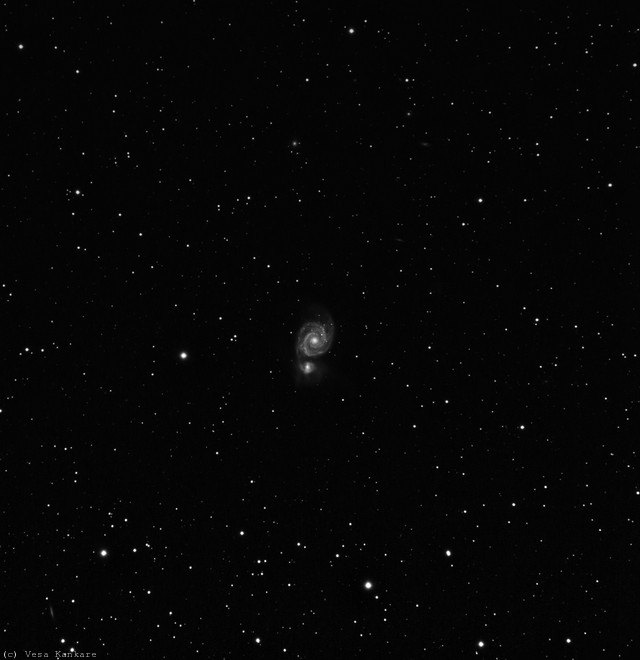
Camera: Atik Instruments 4000LE | Telescope: Skywatcher ED80 Pro 80mm f7.5 refractor, William Optics 0.8x focal reducer | Mount: Vixen GP-D2, Boxdoerfer PowerFlex MTS-3SLP drive controller | Filters: Baader IR/UV block | Guiding: The Imaging Source DMK 21AU04.AS CCD camera, Orion ShortTube 80mm f5 refractor, Stark-Labs PHD Guiding | Exposure: L: 48x180s(2h24m) CCD @ -20°C f6 | Software: CCDWare CCDStack, Adobe Photoshop CS4, Artemis Capture, GradientXTerminator Plugin | Location: 60°31'N 26°52'E (Koivula/Kotka,FI) | Image Field: 1.703 x 1.757 degrees | Image Center: Ra 13h29m47s Dec +47°10'02" | Target altitude in the beginning of the exposure 55°
M101 - The Pinwheel Galaxy
19:10 26/3/2009 UTC
M101 is a very nice photogenic spiral galaxy in Ursa Major. The galaxy is positioned face-on and the spiral arms are very nicely visible. M101 is a large galaxy at 27 million light years away from us. It is almost twice as large as Milky Way and spans 170 000 light years across making it appear quite a large in our sky. M101 is clearly elognated in shape which hints about past interaction with another galaxy.
This image is a composite of CCD luminance and DSLR color data. The color data dates back to the ATM Meet 2007 in Artjärvi. I found a very significant change in my processing method while processing the luminance data and got a much smoother background to this image compared to my previous methods. I think I need to get back to my Leo Triplet image and see if I can get more out of it with the new way.
NGC/IC Object List:
NGC5457 galaxy RA:14h03m12.4 Dec:+54°20m'58" BMag: 8.2, M 101 Pinwheel Galaxy
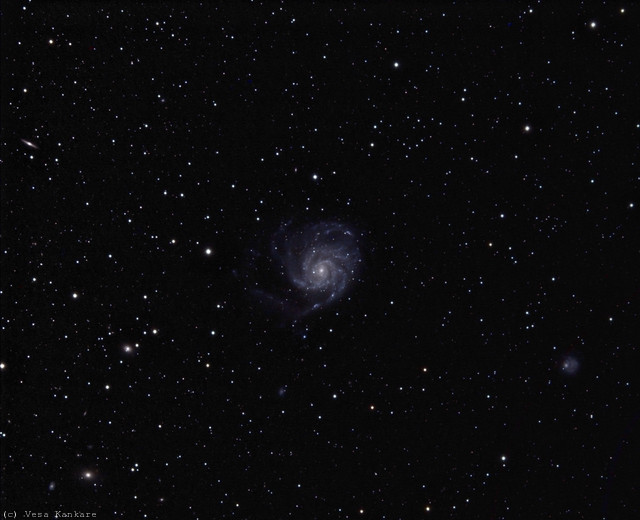
Camera: Atik Instruments 4000LE, Modified Canon EOS 350D | Telescope: Skywatcher ED80 Pro 80mm f7.5 refractor, William Optics 0.8x focal reducer | Mount: Vixen GP-D2, Boxdoerfer PowerFlex MTS-3SLP drive controller | Filters: Baader IR/UV block | Guiding: The Imaging Source DMK 21AU04.AS CCD camera, Orion ShortTube 80mm f5 refractor, Stark-Labs PHD Guiding | Exposure: L: 53x180s(2h39m) CCD @ -20°C + RGB: 8x300s (40m) ISO800 f6 (EOS DSLR) | Software: CCDWare CCDStack, Stark-Labs Nebulosity 2, Adobe Photoshop CS4, Artemis Capture, GradientXTerminator Plugin | Location: 60°31'N 26°52'E (Koivula/Kotka,FI) | Image Field: 1.796 x 1.457 degrees | Image Center: Ra 14h03m00s Dec +54°21'05" | Target altitude in the beginning of the exposure 52°
Leo Triplet
18:26 19/3/2009 UTC
Leo Triplet is a photogenic group of galaxies in the constellation Leo. This group is also known as The M66 Group. These three magnificent spiral galaxies are interacting with each other which causes a long tidal stream of star formation from NGC3628. This over 200 light year long stream of stars is faintly visible in my image upwards from the galaxy.
This image is taken under very dark skies in Ursa Artjärvi Observatory. I don't have LRGB filter set yet, so I decided to recycle one of my old
DSLR image
to add a little color tone to the image. I intentionally left the background a bit bright and didn't do much noise reduction to keep the tidal tail visible.
NGC/IC Object List:
NGC3623 galaxy RA:11h18m55.6 Dec:+13°05m'27" BMag:10.1, M 65
NGC3627 galaxy RA:11h20m15.1 Dec:+12°59m'24" BMag: 9.7, M 66
NGC3628 galaxy RA:11h20m16.7 Dec:+13°35m'24" BMag:10.4, UGC 6350
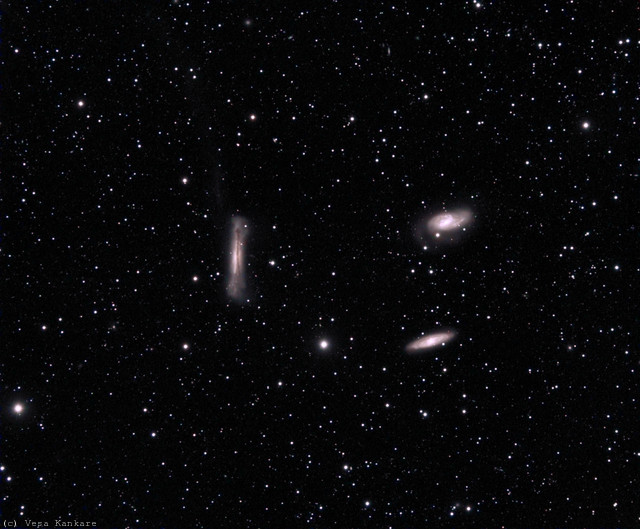
[High Resolution : 2035x1681 @ 3.18 arcsec/pixel]
Camera: Atik Instruments 4000LE, Modified Canon EOS 350D | Telescope: Skywatcher ED80 Pro 80mm f7.5 refractor, William Optics 0.8x focal reducer | Mount: Vixen GP-D2, Boxdoerfer PowerFlex MTS-3SLP drive controller | Filters: Baader IR/UV block | Guiding: The Imaging Source DMK 21AU04.AS CCD camera, Orion ShortTube 80mm f5 refractor, Stark-Labs PHD Guiding | Exposure: L: 24x600s(4h) CCD @ -20°C + RGB: 17x240s (1h8m) ISO800 f6 (EOS DSLR) | Software: CCDWare CCDStack, Stark-Labs Nebulosity 2, Adobe Photoshop CS4, Artemis Capture | Location: 60°44'00"N 26°12'46"E (Tähtikallio Observatory/Artjärvi, FI) | Image Field: 3.835 x 3.253 degrees | Image Center: Ra 02h22m52s Dec -13°35'38" | Target altitude in the beginning of the exposure 30°
IC410 and The Tadpoles in color
17:26 8/3/2009 UTC
IC410 is a HII region in Auriga. This interesting nebula and open cluster hosts two interesting nebulae Sim129 and Sim130. Their appearance resembles tadpoles swimming in the pool of ionized hydrogen. Some sources even titles the object as The Galactic Sperm Nebula. In the middle of the nebula is associated open cluster NGC 1893. It is believed to be one of the youngest known clusters in the sky.
I think I hit a very dim first light object here. I had some problems with noise in the first processing run, but after a while I noticed I had some serious errors in my calibration of the light frames. Anyway, finally the sky was co-operating and I got plenty of imaging time. I did both H-alfa and OIII channels. This image is Ha:OIII:OIII with Ha luminance.
NGC/IC Object List:
NGC1893 open cluster RA:05h22m44.1 Dec:+33°24m'43" BMag: , IC 410
IC410 open cluster RA:05h22m44.1 Dec:+33°24m'43" BMag: , NGC 1893
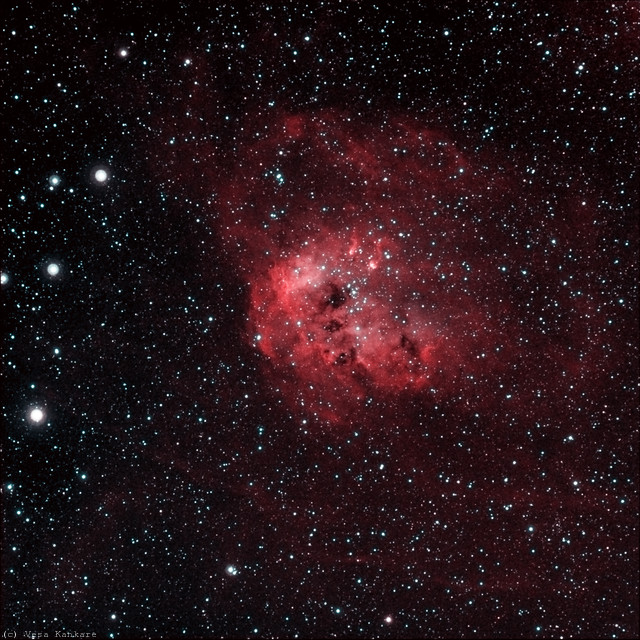
[High Resolution : 2047x2047 @ 3.18 arcsec/pixel]
Camera: Atik Instruments 4000LE | Telescope: Skywatcher ED80 Pro 80mm f7.5 refractor, William Optics 0.8x focal reducer | Mount: Vixen GP-D2, Boxdoerfer PowerFlex MTS-3SLP drive controller | Filters: Astronomik H-alpha 13nm 2", Astronomik OIII 13nm 2" | Guiding: The Imaging Source DMK 21AU04.AS CCD camera, Orion ShortTube 80mm f5 refractor, Stark-Labs PHD Guiding | Exposure: Ha: 12x600s(2h) + OIII: binned 2x2 9x600s(1h30m) f6 CCD @ -20°C | Software: CCDWare CCDStack, Adobe Photoshop CS4, Artemis Capture | Location: 60°31'N 26°52'E (Koivula/Kotka,FI) | Image Field: 1.809 x 1.809 degrees | Image Center: Ra 05h22m13s Dec +33°22'34" | Target altitude in the beginning of the exposure 61°
First light - IC410
20:26 7/3/2009 UTC
Atik 4000LE First Light! Weather was awful and I had some serious hassle with my gear. First of all I set my telescope in a position where trees cut the exposure short and then there was something wrong with PC charger. I burned some 5 fuses while debugging the setup. And if that wasn't enough I forgot to set the mount hand unit to slow speed and screwed up 30 minutes of valuable exposure. Anyway I got my first image with a CCD and this was bad enough weather to spend time on practising. Nothing spectacular in the image but first is a first!
NGC/IC Object List:
NGC1893 open cluster RA:05h22m44.1 Dec:+33°24m'43" BMag: , IC 410
IC410 open cluster RA:05h22m44.1 Dec:+33°24m'43" BMag: , NGC 1893
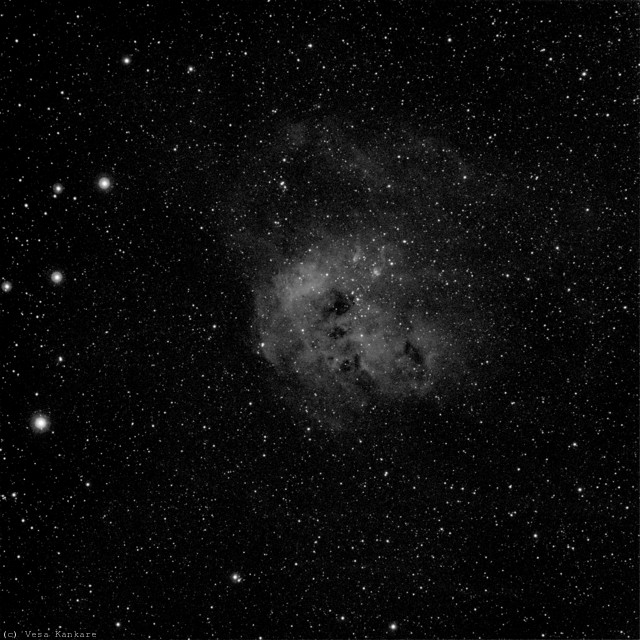
Camera: Atik Instruments 4000LE | Telescope: Skywatcher ED80 Pro 80mm f7.5 refractor, William Optics 0.8x focal reducer | Mount: Vixen GP-D2, Boxdoerfer PowerFlex MTS-3SLP drive controller | Filters: Astronomik H-alpha 13nm 2" | Guiding: The Imaging Source DMK 21AU04.AS CCD camera, Orion ShortTube 80mm f5 refractor, Stark-Labs PHD Guiding | Exposure: Ha: 3x600s (30m) f6 CCD @ -10°C | Software: CCDWare CCDStack, Adobe Photoshop CS4, Artemis Capture | Location: 60°31'N 26°52'E (Koivula/Kotka,FI) | Image Field: 1.808 x 1.809 degrees | Image Center: Ra 05h22m11s Dec +33°23'50" | Target altitude in the beginning of the exposure 43°